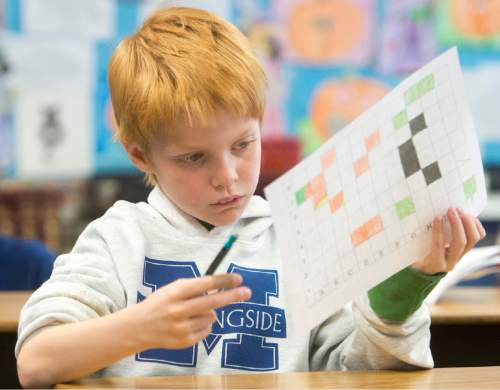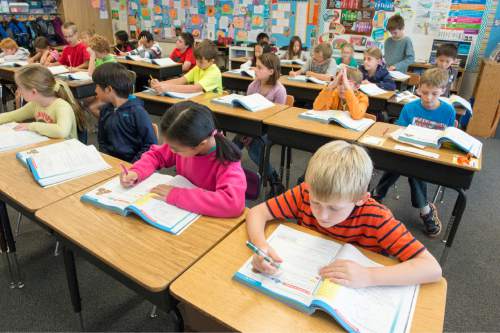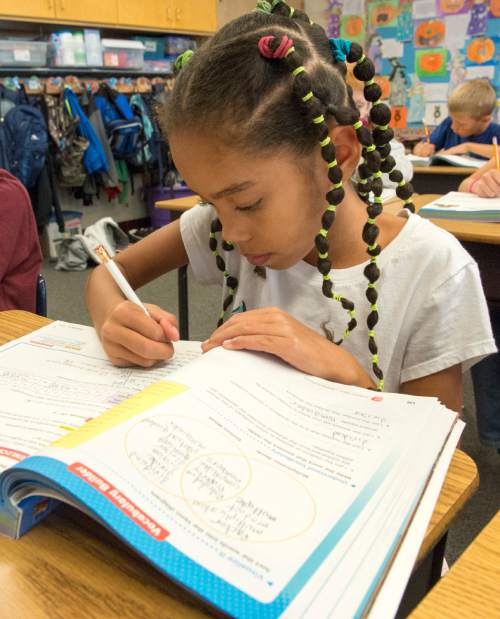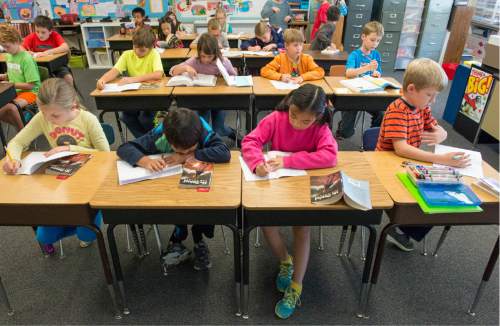This is an archived article that was published on sltrib.com in 2014, and information in the article may be outdated. It is provided only for personal research purposes and may not be reprinted.
Utah's math scores drop in the transition from elementary school to middle school, and largely get worse as students get older.
Students in grades three through 11 take the state's new SAGE tests. Overall, the percentage of students who earned a passing score last year hovered in the mid-40s until fifth grade.
In sixth grade, the proficiency rate dropped to 35.2 percent. Then it immediately bounced back to 43.1 percent in seventh grade.
It's a significant dip that stands out in the comparatively linear SAGE trends, according to data released Monday by the Utah State Office of Education.
"Seventh grade towers over sixth grade," Albion Middle School teacher Hannah Kaier said. "I'm quite shocked because I think the sixth grade teachers worked their butts off."
The sixth-grade dip may be due to the new, more difficult math standards the SAGE test is based on, said Barbara Kuehl, a former math teacher who now works as director of academic services in Salt Lake City School District.
Sixth-grade benchmarks are written as the first year of a middle school education, even though most Utah schools teach sixth grade at the elementary level, she said.
"The sixth grade, I think, made the biggest change from the previous standards to the new standards," she said.
Sixth-graders are now asked to work with fractions, ratios and mathematical modeling in a way that typically came in later grades, she explained.
And elementary educators are asked to teach a middle school curriculum, Kuehl noted.
"This big jump also included a depth of understanding that I think was difficult even for the teachers," she said.
Canyons School District recently bumped sixth grade to the district's middle schools, and ninth grade to the district's high schools, in an effort to group similar academic levels, district spokesman Jeff Haney said.
"We wanted to make sure our ninth graders were truly getting a high school experience," Haney said.
Despite that change, Canyons saw proficiency scores boomerang from 44.5 percent, to 34.8 percent, and back to 52.2 percent in the fifth, sixth and seventh grades.
Kaier, who teaches in Canyons, said the sixth-grade standards introduce new concepts that are built on in seventh and eighth grade.
She said she prefers to be grouped with middle school grades because sixth grade marks a shift from basic arithmetic to higher level learning.
"This is the year that it all comes together," Kaier said. "They now see why they learned the basics in order to problem-solve."
SAGE scores also show a general decline in math proficiency rates as students approach graduation.
The percentage of Utah students scoring proficiently in math starts at 44.3 percent in third grade, climbs to a high of 47.5 percent in fourth grade, then meanders on its way down to 30.1 percent for high school students enrolled in Secondary Math III.
That pattern repeats itself in many of the state's largest school districts.
Nearly half — or 49.2 percent — of third-grade students in Canyons School District tested proficiently in math. But fewer than one in four — or 23 percent — met grade-level expectations in Secondary Math II, the highest level math course tested in the district last year.
Some districts began the process early and have Secondary Math III SAGE scores, while others do not.
Granite School District's third-grade proficiency rate of 33.5 percent is cut in half by the time students reach Secondary Math II — at 15.6 percent. Then the district sees a lift to 23.4 percent in Secondary Math III.
In Salt Lake City, the 44.8 percent of students testing as proficient in third grade drops steeply after the eighth grade, with proficiency rates of 19.9 percent in Secondary Math I, 11.1 percent in Secondary Math II and only 5.9 percent in Secondary Math III.
And in Murray School District, proficiency rates swing from 44.3 percent in third grade to 16.1 in Secondary Math III.
The state average for Secondary Math III was 30.1 percent.
"That is the one thing that I'm a little bit puzzled about," Murray Superintendent Steven Hirase said of his district's high school scores. "Because the majority of our scores are right around the state average."
Kuehl said the trend shows the need to prepare students early to be college and career-ready.
She said the expectations for students increase each year, and any holes in a child's preparation become bigger over time.
"If you don't have them set up and good to go by third grade you're going to pay the price later," she said. "You can make up a lot of ground but it's not the same as if you had them there in the first place."
Utah students have also been faced with a significant redesign of the way math is taught in high school.
Instead of learning algebra one year, geometry the next, followed by more advanced algebra during their junior year, students are now presented with a blend of concepts that increase in difficulty each year.
The switch created logistical challenges in Utah, with schools offering the old and the new courses simultaneously during the early stages of implementation and coping with a lack of textbooks aligned with the new format.
"The older students are struggling because we haven't had good materials available," Kuehl said. "We do now, but Utah implemented fairly early and the publishers and the material producers have been way behind."
Noelani Ioane, a math teacher at Bingham High School in South Jordan, said that students are expected to move forward to the next class whether or not they have mastered skills.
She said as a teacher, it's difficult to teach a concept such as factoring when a student is struggling with multiplication.
"You can only pass the buck so far before it blows up in your face," she said.
Kuehl said that placing students in the right class for their skill level has been a challenge in the first years of the new math standards. But districts are working to create course schedules that better accommodate both struggling and excelling students.
"We're still in the early stages of this but we are creating those opportunities for kids," she said.
bwood@sltrib.com



















